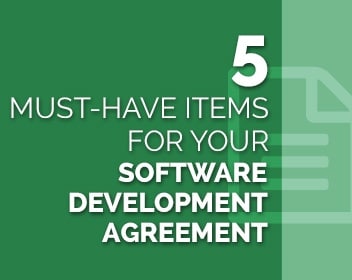5 August 2016
5 Must-Have Items For Your Software Development Agreement
You already know that software development can be complicated.
 Between navigating the feature requirements, development schedule, the scrum timeline – it can be overwhelming.
Between navigating the feature requirements, development schedule, the scrum timeline – it can be overwhelming.
Here’s the thing, your business is going to be spending much more of its time using your custom software than was spent developing it. Don’t neglect post-launch.
So we’re going to outline the 5 most important things you need to make sure are outlined in your software development agreement, and ensure continued success.
You’re about to revolutionize your business with a custom software application – don’t make an expensive mistake by forgetting life after launch!
Item #1: Training
Developing the software application is one thing, learning to use it is something else entirely.
Ignoring onboarding your employees or customers is a disaster waiting to happen. You can’t trust that people will just “pick it up and go”, they need to not only be taught how to use the application, but how to use the application properly.
You’re going to need documentation and training materials that you can pass along to new and existing employees to get them up to speed quickly. Working with the software project lead can go a long way to help bridge the gap since they’ll have a keen understanding of what the software can do.
You’ll want to make sure there’s room in the timeline and budget to account for developing the training documentation you’ll need to get your company up to speed.
Item #2: Support
There’s a catch to all that training – it’s probably not going to get everything.
Your new, amazing piece of software didn’t exist before. So you can’t possibly prepare for everything that will happen after your company uses it.
That’s why a good support plan is essential.
Work with the development team to outline what kind of support they can provide. They should be providing basic support for your employees for a monthly fee, but what if your software is B2C?
If you have thousands of sign-ups in the first day, how will you handle the volume of issues your new customers may create? If a customer has a question, who answers the phone? If it’s going to be your employees, what happens if they need technical assistance?
Don’t leave yourself having to scramble to find answers when the phone is ringing off the hook.
Item #3: Bug Reporting
Here’s the deal: bugs happen.
Software isn’t 100% foolproof; there are going to be situations where it does something odd or doesn’t do anything at all. Every software company from Apple and Google on down has to deal with bugs; it’s just the nature of software development.
Make sure you have a plan in place for when one is found.
There should be some kind of reporting plan so if your employees or customers find a bug, you can get the information to the right people. It should strive to include what information is needed, but since that’s sometimes hard to do, we usually use this rule of thumb:
“What happened? What did you do to cause that to happen? What did you expect to happen?”
Those three questions should get you most of the way there. After that is how to set priority of bugs and to find out when they’ll be patched with a new release. All things you’ll want to be outlined before launch.
Item #4: Server Maintenance and Backups
It’s not the sexiest item on this list, but it’s vital to include and make sure there’s a plan in place.
With the advent of cloud server architecture and Docker deployment, there is no excuse to be left in a situation of extended downtime. If a server is properly maintained and monitored, backups are taken regularly, then you’ll have the peace of mind knowing if the worst happens you’ll be right back on your feet.
If a disaster hits your software application, there’s a world of difference between being back up in minutes vs. days.
Item #5: Upgrades
The software world is always changing. There are new features, plugins, APIs, frameworks – the environment is ever-evolving.
Your business is changing too. You need to be agile to keep your customers happy and coming back to you instead of your competition.
The last thing you want is to be shackled to a legacy system that’s more cobwebs than code.
An upgrade path is vital to the longevity of your project. You’ll want to make sure you have the budget and development room available to respond to changing conditions or new ideas.
Because if you don’t, your competition will be more than happy to.
The Bottom Line
You need to be prepared for what your software is going to be like after launch. To ignore it could leave you with having to scramble. This will force you to make expensive decisions that could have been done months ago.
Need to know more? We’re offering a free 30-minute demo to answer any questions you may have, click the image below to schedule yours!

